ASUS PQ321Q UltraHD Monitor Review: Living with a 31.5-inch 4K Desktop Display
by Chris Heinonen on July 23, 2013 9:01 AM ESTUniformity is tested by using 25 locations across the screen and measuring the color checker chart at each of them. From there we can pull out contrast, black and white uniformity, and color uniformity. This review is the first to utilize the newest measurement available in CalMAN 5.1.2: dE From Center. Now instead of measuring the dE2000 at every location, we measure it relative to the center measurement.
This gives us a true uniformity measure. I could measure the left side and the right side of the monitor and get a dE2000 of 2.0 for each side. What that doesn’t tell me is that the left side might be red tinted, and the right side blue tinted, while the center might be green tinted. In this case they could all measure the same dE2000, but look totally different. By comparing the measured values to the center, we get an actual measurement of if one area of the screen will look the same as another area. Since we always use the center of the screen as our calibration target, which is why everything is measured relative to that.
Starting out with White Uniformity, we see decent but not amazing results. The panel stays within +/- 10% for the center, but falls down to a 17% variation at the edges. The light fall-off is relatively high, and makes me wonder if the look of the panel, and its thin design, might place a bit of emphasis on style over substance.
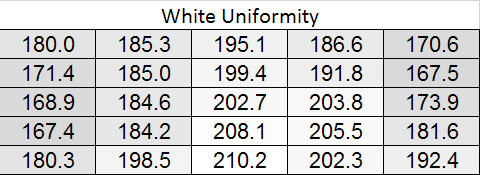

With the black level charts we see similar results. The middle of the panel is +/- 10% again, but the edges fall off to a nearly 20% difference. There is a curious rise in black level in one measure where there was a fall-off in white level, but otherwise the results between the two measurements are similar.
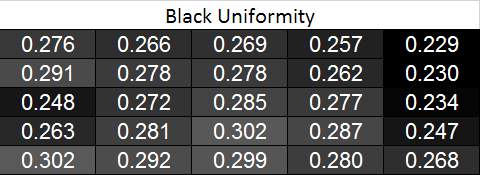
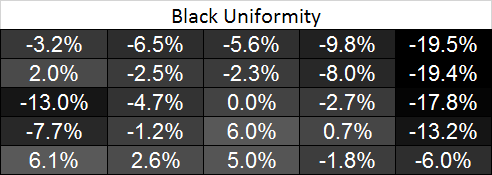
Looking at the resulting contrast, the numbers here are much closer to 100%, which we expect to see. Areas with light fall-off affect the white and black levels almost equally, so the contrast ratios are very similar all across the screen. That gives us a 700:1 expected contrast ratio for the screen as a whole.
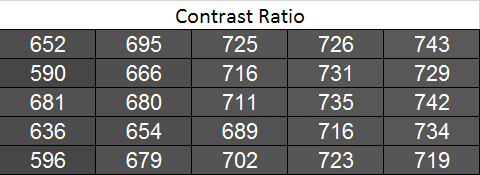
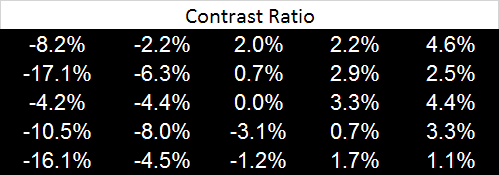
Now we can see the new dE2000 From Center data. The issues here crop up at the outsides of the screen, where we see the backlighting issues earlier. Uneven lighting is the issue most likely to cause color issues on the screen, and that is certainly backed up here. In the center of the screen, you are going to not see a difference in colors when you look directly at the screen. With a light loss of less than 10%, and a color dE2000 of <2 for most of the center screen, everything will look identical. As you get to the extreme edges you will run into more issues. I will need more monitors to be tested with this new method, but I think this is going to wind up as a good result in the end.

Going with an LED lighting system, and not a backlit array one, is always a bit of a concern for me. Overall the PQ321Q does well for uniformity for using one, and it avoids some of the massive issues we have seen with some LED systems before. But we are looking for near-perfection from the ASUS and it can’t quite do that. The center 60% of the screen is excellent overall, and for most people that will mean you may not notice these issues at all, but they are there.










166 Comments
View All Comments
psuedonymous - Wednesday, July 24, 2013 - link
The paper also mentions that cycles/degree is only ONE of the ways that the eyes perceive 'detail' When it comes to line misalignment (i.e. aliasing), we can see right down to the arcsecond level. If you want a display that does not exhibit edge aliasing, you're looking at several tens of thousands of DPI.twtech - Tuesday, July 23, 2013 - link
Even if you can't see the individual pixels, you'll still notice a difference in the clarity of the display.EnzoFX - Tuesday, July 23, 2013 - link
I cannot believe people who are saying 4k is a waste on TV's, this is asinine. 1080p on a large tv is terrible, the pixels are clearly visible.1Angelreloaded - Wednesday, July 24, 2013 - link
Well lets be honest, its only usefull to us if the PPI is high enough to throw AA out the window, or atleast down to 2x of any iteration. I can see some uses in productivity or workstation applications. As for the TV market they aren't even fully at a standard 1080p in content, and they invested a lot into upgrading content as Hollywood started upgrading the cameras for higher resolutions, so I don't see the industry on a bandwagon to keep upgrading.SodaAnt - Tuesday, July 23, 2013 - link
720p is about as good as you need if you have a 50" TV and you sit 10 feet away from it. If you have a 30" display that you sit 18 inches from, it makes a huge difference.smartthanyou - Tuesday, July 23, 2013 - link
No person has ever made such a blanket statement. It has always been in the context of what was being viewed and the distance to the display.In the future, consider your posts more carefully before you put in writing that you are an idiot.
NCM - Tuesday, July 23, 2013 - link
So evidently you didn't make it even to the end of the article's first paragraph?CalaverasGrande - Thursday, December 26, 2013 - link
I suppose since I work in broadcast I am special but 4k, HD and 720 are all apparent when you have a decently sharp display. Even from several feet away.karasaj - Tuesday, July 23, 2013 - link
I just had an argument with my friend over why laptops around 15" are getting 3200x1800 displays but we still have < 100 ppi on desktop displays.We both agreed that it would be nice to have high DPI desktop monitors but i insisted that they're too expensive and more niche than laptops and tablets.. It's crazy to see the first 4k monitor ever get such a nice reward, what do you think prevents the cost from going down yet?
bryanlarsen - Tuesday, July 23, 2013 - link
Displays, like IC's, get exponentially more expensive as the size increases, especially for newer technologies. It's mostly due to the defect ratio. A 30" screen is 4 times as large as a 15" one, but it's way more than 4x as expensive. Suppose that there's a single fatal defect; the 30" screen would have to be discarded, but 3/4 of the 15" panels would be fine.